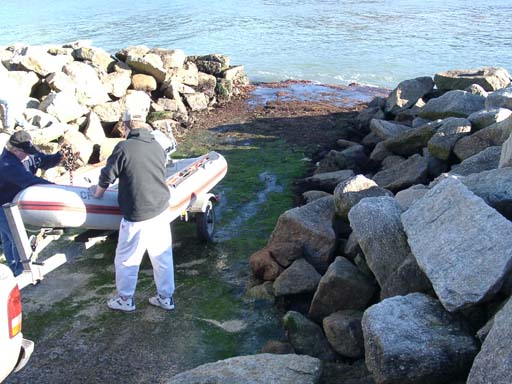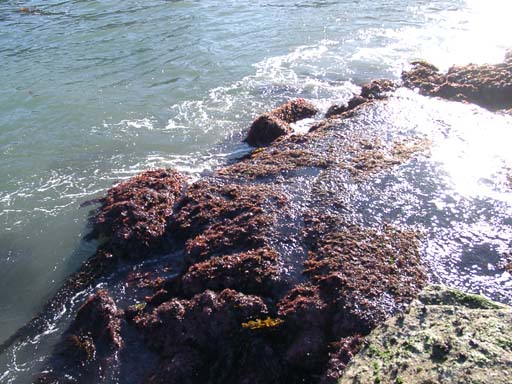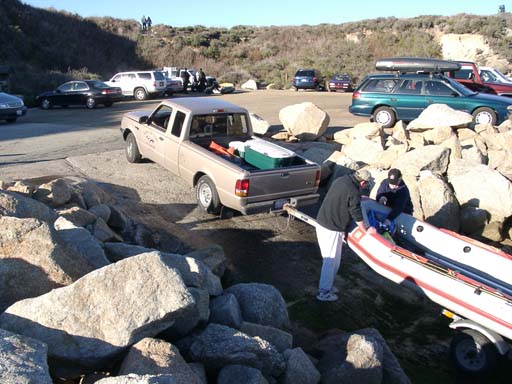 Launching
at Pt. Lobos
Launching
at Pt. Lobos
 There
are three words to describe the launch ramp at Pt. Lobos: horrid, awful,
and atrocious.
There
are three words to describe the launch ramp at Pt. Lobos: horrid, awful,
and atrocious.
The upper part is too steep, the lower part isn't steep enough, and it ends at about the zero tide line with a vertical drop into about six feet of water. That means that there are a fair number of days when the only way to put your boat on the trailer is to pick it up by hand. At the lowest low tide of the year, at the full moon in December or January, the water is 18" below the end of the ramp.
Add that the ramp is narrow, potholed, may have big rocks on it, and you have to make a tight 90 degree turn to get your boat on the ramp. So why would anyone would launch anything bigger than a kayak there? Ans.: You gotta launch at Pt. Lobos to boat dive at Pt. Lobos. (Well, not quite, there are ways, but they get at least as complicated as launching).
So, how do you survive launching at Lobos?
 First,
you gotta pick your days. If you have a small inflatable with launching
wheels, it won't matter much, but when you have a 14' RIB, you gotta
plan some, and with a 17' whaler, you gotta plan a lot. Check the
tide tables, and figure out what you think you can deal with. With
my whaler, I like a +2.5 tide from 10 a.m. to 4 p.m. That happens
about four days a month. Paul Braunbehrens has the same boat, and
he'll go as low as +2. Start conservative, and work down. BTW,
in the tide tables, Whaler's Cove is called Carmel Cove.
First,
you gotta pick your days. If you have a small inflatable with launching
wheels, it won't matter much, but when you have a 14' RIB, you gotta
plan some, and with a 17' whaler, you gotta plan a lot. Check the
tide tables, and figure out what you think you can deal with. With
my whaler, I like a +2.5 tide from 10 a.m. to 4 p.m. That happens
about four days a month. Paul Braunbehrens has the same boat, and
he'll go as low as +2. Start conservative, and work down. BTW,
in the tide tables, Whaler's Cove is called Carmel Cove.
 Getting
your trailer on the ramp is a bit tricky because it's narrow, and you have
to make that turn. It's a lot easier if there's nobody parked in
front of the bathrooms. If I'm near the front of the line to get
in, I just park parallel there so nobody grabs the spot while I'm setting
up the boat. I start just behind the cars parked on the bathroom
side of the lot and angle back toward the ramp, aiming to put the right
side of the trailer about three feet out from the inside of the corner.
There are three positions for the steering wheel on this ramp, straight,
all the way left, and all the way right. You are either going straight,
or turning hard. Just as the trailer tires leave the pavement, I
crank the wheel all the way, stick the trailer as far down the ramp as
I can, turn the wheel all the way the other way, and pull forward.
If I did it right (one time in five) I've now got the trailer pointed right
down the ramp, and can just back up. The rest of the time, it's a
matter of jockeying back and forth. You want to end up with the stern
pointed a little away from the ocean (to avoid the rocks on the ocean side)
and the truck a bit off-center to the right in the ramp to facilitate getting
back out.
Getting
your trailer on the ramp is a bit tricky because it's narrow, and you have
to make that turn. It's a lot easier if there's nobody parked in
front of the bathrooms. If I'm near the front of the line to get
in, I just park parallel there so nobody grabs the spot while I'm setting
up the boat. I start just behind the cars parked on the bathroom
side of the lot and angle back toward the ramp, aiming to put the right
side of the trailer about three feet out from the inside of the corner.
There are three positions for the steering wheel on this ramp, straight,
all the way left, and all the way right. You are either going straight,
or turning hard. Just as the trailer tires leave the pavement, I
crank the wheel all the way, stick the trailer as far down the ramp as
I can, turn the wheel all the way the other way, and pull forward.
If I did it right (one time in five) I've now got the trailer pointed right
down the ramp, and can just back up. The rest of the time, it's a
matter of jockeying back and forth. You want to end up with the stern
pointed a little away from the ocean (to avoid the rocks on the ocean side)
and the truck a bit off-center to the right in the ramp to facilitate getting
back out.
Four-wheel-drive helps a lot to get up the steep, slippery, ramp.
Getting the truck off the ramp isn't hard if you have a short trailer, but of you have a nice long trailer that keeps your truck dry, pull straight forward, then cut hard left until you almost hit the boat sheds, stop, cut hard right, back up a bit to jackknife the trailer (make sure it doesn't hit your rear bumper or the rocks), cut hard left, and you are free. Watch the left trailer wheel to make sure it doesn't run too tight.
Now that you've launched, you have to go drop the trailer up on Rat Hill. Drive back up past the Whaler's Cabin, cross the main road, ignore the "authorized vehicles only" signs and drive up the hill. Before the maintenance shed, there are parking spots on both sides. Pick a spot, drop the trailer, chock the wheels, drive back down to Whalers', and go diving.
Some folks have resorted to "extraordinary measures" to launch at Pt. Lobos:
- My trailer came with a very long tongue, and I modified it to be removable (so it fits in the garage) and extensible by about 18". This helps keep the truck dry.
- My trailer also sets the boat low and between (rather than above) the wheels. The keel is only about 12" off the pavement. Most trailers for inflatables have the boat way up in the air above the wheels.
- I've seen folks use a winch or tow strap to pull the trailer out, chock the wheels, and then hitch up. I've even seen electric winches mounted on the back of the truck.
- Small inflatables can use transom mounted wheels to roll the boat down the ramp.
After you're done diving, go get the trailer, back it down (it's OK to get out and drag the trailer around, but grab the strong frame, not the bunk boards), load up, and pull out again. You can rinse your boat, but please get your rig as far to the left as possible. The trailer should be within about six inches of the water pipe, and the truck should have the left wheels off the pavement. Pull fairly far forward so there's room behind the trailer for other divers to clean their gear, or stay way back so they can pass between you boat and truck. Another option, provided you know what's going on with any other boats there that day, is to leave the rig on the ramp, but pull forward to be sure your truck stays dry, and be well to one side (left is best) so divers can get in and out. If you are dead center with a big rig, neither side works for the beach divers.
I bring my own hose and spray nozzle as the hoses at Pt. Lobos are usually in pretty sorry shape from having been run over a zillion times.
Finally, be nice to the rangers. They will probably show up while you are in line, open the gate for them. Be polite. Ask questions. Most of them are biologists by training (and inclination), but are cops by trade (note the 10 mm and Kevlar) and take some undeserved shit for it. It always pays to be nice to the fuzz. BTW, the state lifeguard, who will sometimes have the duty at Pt. Lobos, is usually a surfer by inclination, cop by trade. Same situation.
If you have a dive reservation, you can bring a boat. There are four boat reservations a day, but they are for non-divers, usually recreational kayakers. Your $10 dive reservation fee doesn't cover admission to the park which is another $8, or you can get an annual pass if you are a regular.